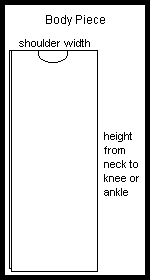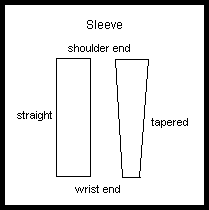Basic Russian T-tunic Pattern
by Lady Sofya la Rus, Mka Lisa Kies
inspired by a class given
by
HL Seraphima Iaroslavna [sic]
This pattern can be modified to make almost any Russian garment. Rightly or
wrongly. Drawings are not to scale.
Putting together the tunic.

Making the tunic pattern
Warning: These instructions do not provide for seam allowances, hems, etc.
Materials:
Measurements:
 Body piece:
Gusset: this piece is completely optional, but I recommend using it.
This is a simple square, 3-5 inches on a side (8-13 cm), depending on how
big you are. I don't think the size matters as much for the fit of the
garment as for the proportion. I might be wrong.
Body piece:
Gusset: this piece is completely optional, but I recommend using it.
This is a simple square, 3-5 inches on a side (8-13 cm), depending on how
big you are. I don't think the size matters as much for the fit of the
garment as for the proportion. I might be wrong.
 Sleeve:
Can be cut straight or tapered.
Sleeve:
Can be cut straight or tapered.
 Side panels: can be cut straight or tapered.
Double check everything.
Side panels: can be cut straight or tapered.
Double check everything.
Transfer to your pattern paper.
Make an example of the garment out of your inexpensive fabric and make final
adjustments to your pattern.
Send comments or questions to lkies@jumpgate.net
Return to Russian Materials.
| 
 Body piece:
Gusset: this piece is completely optional, but I recommend using it.
This is a simple square, 3-5 inches on a side (8-13 cm), depending on how
big you are. I don't think the size matters as much for the fit of the
garment as for the proportion. I might be wrong.
Body piece:
Gusset: this piece is completely optional, but I recommend using it.
This is a simple square, 3-5 inches on a side (8-13 cm), depending on how
big you are. I don't think the size matters as much for the fit of the
garment as for the proportion. I might be wrong.
 Sleeve:
Can be cut straight or tapered.
Sleeve:
Can be cut straight or tapered. Side panels: can be cut straight or tapered.
Double check everything.
Side panels: can be cut straight or tapered.
Double check everything.